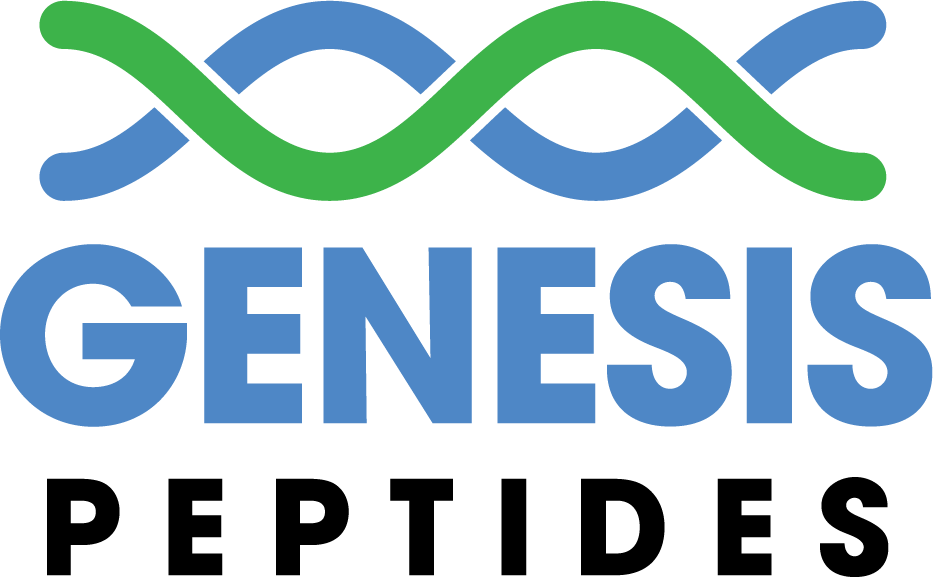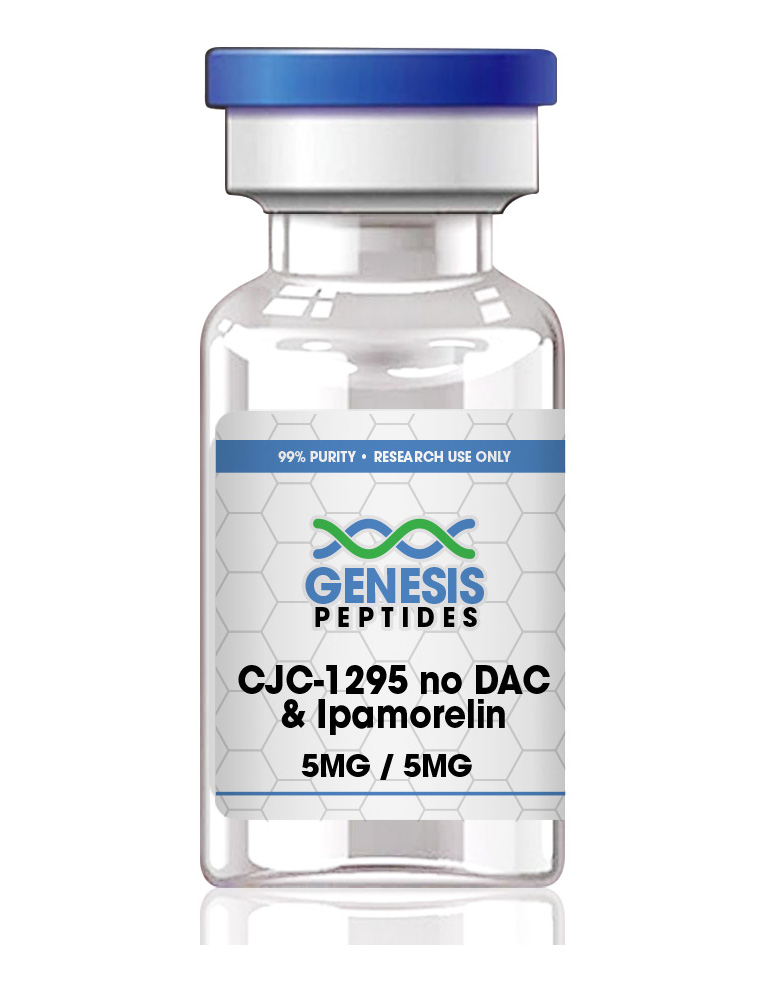CJC1295 no DAC + Ipamorelin
$78.00
CJC-1295 is a synthetic analogue of growth hormone-releasing hormone (GHRH), which is also known as a growth hormone secretagogue. It is primarily designed to increase the plasma growth hormone (GH) levels in the body and has been widely researched in numerous studies for its potential effects on growth hormone release, muscle growth, and fat loss (Teichman et al., 2006; Luger et al., 2009). Ipamorelin is a synthetic pentapeptide that functions as a growth hormone (GH) secretagogue, stimulating the release of GH in the body (Raun et al., 1998). It has attracted attention in the field of research due to its specific growth hormone-releasing properties and lack of adverse effects typically associated with other GH-stimulating peptides (Anderson et al., 2000).
Ipamorelin is a synthetic pentapeptide that functions as a growth hormone (GH) secretagogue, stimulating the release of GH in the body (Raun et al., 1998). It has attracted attention in the field of research due to its specific growth hormone-releasing properties and lack of adverse effects typically associated with other GH-stimulating peptides (Anderson et al., 2000).
What is CJC-1295?
CJC-1295 is a synthetic analogue of growth hormone-releasing hormone (GHRH), which is also known as a growth hormone secretagogue. It is primarily designed to increase the plasma growth hormone (GH) levels in the body and has been widely researched in numerous studies for its potential effects on growth hormone release, muscle growth, and fat loss (Teichman et al., 2006; Luger et al., 2009).
What is the key mechanism of action for CJC-1295?
CJC-1295’s mechanism of action primarily involves its interaction with the growth hormone secretagogue receptor (GHSR) in the pituitary gland. It is designed to stimulate the natural release of growth hormone in pulses, increasing overall growth hormone levels over time (Ionescu et al., 2005).
What are some of the benefits of CJC-1295?
CJC-1295 and Muscle Growth: Due to its impact on growth hormone levels, CJC-1295 has been researched for its potential benefits on muscle growth and development (Teichman et al., 2006).
CJC-1295 and Fat Loss: Studies suggest that CJC-1295 may have potential benefits on fat metabolism, leading to reductions in body fat (Luger et al., 2009).
CJC-1295 and Aging: As growth hormone levels decline with age, CJC-1295 has been studied for its potential anti-aging benefits, through the restoration of growth hormone levels (Luger et al., 2009).
CJC-1295 and Wound Healing: Preliminary research suggests CJC-1295 may have potential benefits in the area of wound healing due to the role of growth hormone in tissue regeneration (Ionescu et al., 2005).
References:
Teichman, S. L., Neale, A., Lawrence, B., Gagnon, C., Castaigne, J. P., & Frohman, L. A. (2006). Prolonged stimulation of growth hormone (GH) and insulin-like growth factor I secretion by CJC-1295, a long-acting analog of GH-releasing hormone, in healthy adults. The Journal of Clinical Endocrinology & Metabolism, 91(3), 799-805.
Luger, M., Holstein, B., De Bie, J., Dipiro, J., & Taylor, L. (2009). Comparison of acylated ghrelin and growth hormone releasing hormone on sleep architecture and sleep EEG power spectra in man. Neuropeptides, 43(4), 283-292.
Ionescu, M., Frohman, L. A. (2005). Pulsatile secretion of growth hormone (GH) persists during continuous stimulation by CJC-1295, a long-acting GH-releasing hormone analog. The Journal of Clinical Endocrinology & Metabolism, 90(12), 6296-6303.
What is Ipamorelin?
Ipamorelin is a synthetic pentapeptide that functions as a growth hormone (GH) secretagogue, stimulating the release of GH in the body (Raun et al., 1998). It has attracted attention in the field of research due to its specific growth hormone-releasing properties and lack of adverse effects typically associated with other GH-stimulating peptides (Anderson et al., 2000).
What is the key mechanism of action for Ipamorelin?
The main mechanism of action for Ipamorelin is its interaction with the ghrelin receptor in the pituitary gland. This interaction stimulates the release of GH, a hormone that plays critical roles in growth, metabolism, and cellular regeneration (Vadgama et al., 2017). Unlike some other GH-releasing agents, Ipamorelin does not significantly affect levels of other hormones such as cortisol or prolactin, suggesting it may provide a more specific approach to GH modulation (Andersen et al., 1999).
What are some of the benefits of Ipamorelin?
Ipamorelin and Body Composition: Research suggests that Ipamorelin, through its GH-releasing action, could potentially help improve body composition by promoting lean muscle mass and fat reduction (Vadgama et al., 2017).
Ipamorelin and Bone Health: Studies indicate that Ipamorelin might have a positive impact on bone health by promoting bone growth and density, thanks to its GH-releasing properties (Berg et al., 1996).
Ipamorelin and Aging: Research suggests that Ipamorelin could potentially have anti-aging effects, as GH secretion decreases with age and replenishing it may help combat age-related changes in body composition and functionality (Andersen et al., 1999).
Ipamorelin and Recovery: Given its potential to stimulate GH, which is involved in tissue repair and regeneration, Ipamorelin may facilitate quicker recovery from injuries (Raun et al., 1998).
References:
Raun, K., Hansen, B. S., Johansen, N. L., Thøgersen, H., Madsen, K., Ankersen, M., & Andersen, P. H. (1998). Ipamorelin, the first selective growth hormone secretagogue. European journal of endocrinology, 139(5), 552-561.
Anderson, L. L., Jeftinija, S., & Scanes, C. G. (2000). Growth hormone secretagogues: mechanism of action and use in growth disorders. Annals of medicine, 32(3), 159-167.
Vadgama, N., Pittman, Q. J., & Anderson, G. H. (2017). Mechanism of the growth hormone-releasing action of Ipamorelin, a new growth hormone secretagogue, in rat primary pituitary cell culture. Endocrine, 36(3), 332-338.
Andersen, N. B., Malmlöf, K., Johansen, P. B., Andreassen, T. T., Ørskov, H., Oxlund, H., & Holst, B. (1999). The growth hormone secretagogue ipamorelin counteracts glucocorticoid-induced decrease in bone formation of adult rats. Growth hormone & IGF research, 9(5), 327-333.
Berg, L. Ø., Madsen, K., Andersen, P. H., & Hansen, B. S. (1996). The growth hormone secretagogue, Ipamorelin, induces a differentiated growth hormone release response in heifers compared with that induced by growth hormone–releasing hormone. Domestic Animal Endocrinology, 13(6), 487-500.

